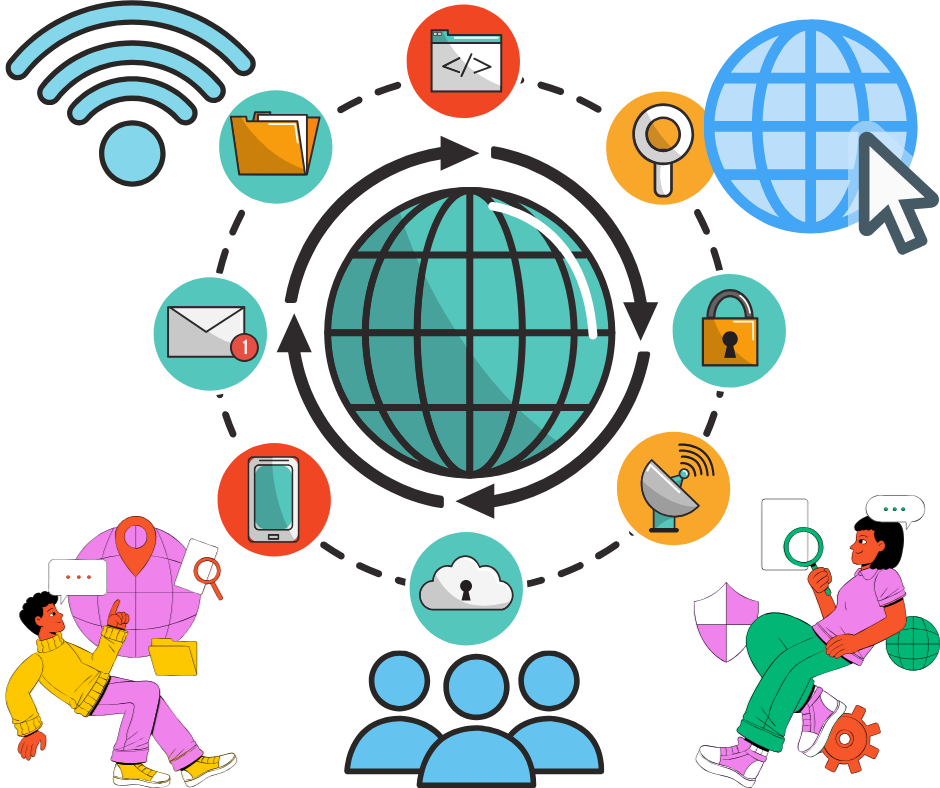Like power and water, the internet is a basic necessity in the twenty-first century. Being used for business, education, or just communication convenience, the Internet has become a necessity rather than a luxury. However, for millions of residents of rural and remote areas, getting reliable high-speed internet still needs to be within reach. The significant ISPs are sometimes unable to meet the needs of these regions; residents of these areas are left with limited choices and many problems.
Now, the savior, Nomad Internet, is the company that isn’t just addressing small-town America’s concerns but redefining what it means to have a stable connection in said areas. For its technology, customer-oriented focus, and mission to solve the digital divide problem, Nomad Internet is America’s choice for rural Internet connection.

Content
The Rural Connectivity Challenge: A Persistent Digital Divide
During the modernization process in the United States, the problem of a digital divide between urban and rural territories has become an essential and prolonged concern. As for communications, urban dwellers have broadband access and can access high-speed Internet through fiber-optic connections or 5G Wireless Internet. On the other hand, rural citizens require assistance with slow, limited, and low-reliability internet services. That is why many residents in less populated areas cannot access ISPs’ services: existing ISPs are loath to devote capital and resources to creating new networks that cannot support themselves due to the relatively low density of customers.
This needs to be corrected, and when coupled with the fact that the above disparity has far-reaching implications. This is specifically true for students in rural areas who may require assistance obtaining online resources to be at par with their urban counterparts. These sections’ small businesses struggle to compete in the current digital economy, and healthcare providers require assistance in bringing telemedicine, which is crucial in rural areas, into their businesses. Another negative impact of the unreliable internet is the limitation of remote working, which has become vital to the new normal. Digital media exacerbates inequalities and marginalization of rural communities regarding economy and interaction.
Nomad Internet: A Beacon of Hope for Rural America
Realizing that there was a desperate need for dedicated and fast internet in rural areas, Nomad Internet has come up with a solution that caters more than just to the niche requirements of such areas. Unlike conventional ISPs that invest much money in vast wire-line infrastructure, Nomad Internet employs the latest wireless technology to deliver fast and reliable internet connections in some areas without internet access. This way resolves the problems of conventional rural internet services and establishes a new possibility that can be obtained in these locations.
Indeed, Nomad Internet’s decision to provide quality internet services to customers in areas that conventional service providers have deemed unprofitable is not just good business; it is a mission born out of recognizing the centrality of connection in the current world. Staying squarely in rural America, Nomad Internet has developed a service that does more than fill a need. Instead, it provides a service that has been unheard of in terms of reliability and speed.
Cutting-Edge Technology: The Backbone of Nomad Internet
The fact that differentiates Nomad Internet from other rural ISPs is that it utilizes the best technologies. Whereas most rural ISPs use old satellite connections or, at times, slow DSL services, Nomad Internet uses features such as 4G LTE and C-Band to provide high internet in homes and businesses in rural regions.
Of them, C-Band technology has been particularly transformative. It provides a much broader connection than satellite or DSL links, enabling Nomad Internet to offer download speeds of up to 200 Mbps in areas where it was almost impossible to dream of such speeds. This means that the internet available to rural dwellers is as good as that available to urban dwellers in terms of download and upload speeds, latency, and the reliability of the connection.
In addition, Nomad Internet’s approach of working with wireless systems frees them from obligations to invest millions of dollars in fiber-optic cable, for example, for laying lines across tens of miles. This flexibility allows the Nomad Internet to swiftly and efficiently expand its service to new areas, ensuring that more and more rural communities can benefit from high-speed internet.
Customer-Centric Service: Putting Users First
Technology is just a piece of the puzzle. A big reason why Nomad Internet has been so successful is because they are fanatical about customer satisfaction. Nomad knows that delivering quality Internet connections is more than speeds and feeds — it’s also about providing a pleasant user experience.
Nomad Internet offers five-star service when customers enroll and continue through account security. The setup process is seamless, and you can install it without any hassle; the instructions are step-by-step and offer good customer support for those troubleshooting moments. They also have a reputation for fast customer service, being highly knowledgeable, and genuinely invested in ensuring everyone enjoys their product.
In the questionable customer service industrial complex, itinerant data dealers in this ocean of providers, such as Dragonfly, look like St George. Nomad Internet will help you through any technical issues, walk alongside you in your plan selection, and answer any of our internet questions with a genuine smile.
Nomad Internet vs. The Competition: Why It’s Number One
While several internet service providers offer rural connectivity, Nomad Internet is the clear leader for several reasons. First and foremost is its unmatched technology, which provides faster and more reliable internet than many competitors. For example, while T-Mobile Home Internet offers speeds ranging from 33 to 245 Mbps, these speeds can vary greatly depending on location, signal quality, and cellular traffic. Thanks to its advanced C-Band technology, Nomad Internet consistently delivers high-speed internet even in the most remote areas.
HughesNet, another competitor, is a satellite internet service virtually available in any area the satellite signal can access. However, HughesNet’s speeds are limited, with plans offering between 15 and 50 Mbps Speed Connection. Furthermore, HughesNet restricts data on its plans, which may prove a disadvantage for users who require a lot of MB for activities such as streaming, gaming, and working from home. Indeed, Nomad Internet, which offers services at much higher speeds and has no data limits, is a much better proposition for people in rural areas.
Another internet service provider available to rural customers is AT&T Internet, which has different plans with moderate to ultra-fast speeds. However, it is understood that AT&T does not offer as many services as Nomad Internet, although the company’s plans can cost more. Moreover, Nomad Internet’s service is significantly faster and more affordable than AT&T’s fixed wireless service, which people often have no choice but to use.”
While the company is in 18 states, Kinetic Internet provides fiber optic technology to some rural areas. Kinetic Internet services range from 500 Mbps to 8 Gbps. This may sound great, but for all its efforts, Kinetic is a service inaccessible to rural residents, and after the introductory offer, the prices are much higher. On the other hand, Nomad Internet offers consistent pricing and reliable service without surprise rate hikes.
Verizon 5G wireless internet is a broadband connection that runs on a cellular 5G network; the company offers two home service plans. However, Verizon provides a somewhat restricted availability of 5G, and where 5G is not accessible, a customer has to connect to a 4G LTE network. Again, Nomad Internet’s service covers all the states, giving users a chance to have a fast and reliable internet connection.
Looking Ahead: The Future of Rural Connectivity
With Nomad Internet’s ongoing efforts to broaden its scope and improve its technology, rural connection has a promising future. Expanding its coverage area to include more rural regions and developing even quicker and more dependable wireless technologies are two ways the company always looks for new ways to improve its services. Nomad Internet’s dedication to innovation guarantees that it will continue to lead the rural internet revolution by offering state-of-the-art solutions that satisfy its clients’ changing needs.
However, Nomad Internet’s goals extend beyond just offering internet access. The company is committed to leaving no American behind, ensuring every resident has the tools and the know-how they need to compete successfully in today’s digital economy. Their dedication to this principle is evident in everything Nomad Internet does; it can be no better described than their devotion to quality customer care and love for the latest tech available.
Why Nomad Internet is the Best Choice for Rural America?
Internet service providers are critical and essential for rural areas with fewer options. Between its cutting-edge technology, customer-oriented service approach, and dedication to rural towns across America, the decision is easy for anyone seeking dependable high-speed internet in remote regions — it has got to be Nomad Internet. If you are a student, small business owner, remote worker, or simply an individual wanting to stay connected, Nomad Internet has the answer!
In a world that demands connectivity, Nomad Internet is not just another ISP; it’s an essential tool for rural America to overcome its technological inaccessibility and connect so that every citizen can access the modern internet equally. Nomad Internet is making a path of what the connection will be like and will ceaselessly alter the future world of rural connection. Being the internet that connects rural America, Nomad Internet is not just an internet service company for America’s hinterland. Still, it is a lifeline to a world that may seem to be leaving the physical domain behind as it goes all digital. Nomad Internet means that the future of rural connectivity is impressive, and there are no limits to what can be achieved.

Glen Macey is an expert in all things technology. He enjoys writing blogs about how to use the latest software and hardware on the market, while also providing advice for using existing technology more effectively. His favorite pastimes include reading comic books and playing video games.






